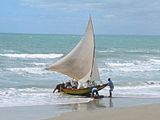
A schooner is a type of sailing vessel defined by its rig: fore-and-aft rigged on all of two or more masts and, in the case of a two-masted schooner, the foremast generally being shorter than the mainmast. A common variant, the topsail schooner also has a square topsail on the foremast, to which may be added a topgallant. Differing definitions leave uncertain whether the addition of a fore course would make such a vessel a brigantine. Many schooners are gaff-rigged, but other examples include Bermuda rig and the staysail schooner.

A dory is a small, shallow-draft boat, about 5 to 7 metres or 16 to 23 feet long. It is usually a lightweight boat with high sides, a flat bottom and sharp bows. It is easy to build because of its simple lines. For centuries, the dory has been used as a traditional fishing boat, both in coastal waters and in the open sea.

Marsaxlokk is a small, traditional fishing village in the South Eastern Region of Malta. It has a harbour, and is a tourist attraction known for its views, fishermen and history. As of March 2014, the village had a population of 3,534. The village is also known for the Marsaxlokk Market, which is mainly a large fish market which takes place along the seafront on Sundays, and a tourist market during all other days of the week. Inhabited and well-known since antiquity, Marsaxlokk was used as a port by Phoenicians, Carthaginians and also has the remains of a Roman-era harbour. Originally a part of the city of Żejtun, the fishing village became a separate parish in the late nineteenth century.
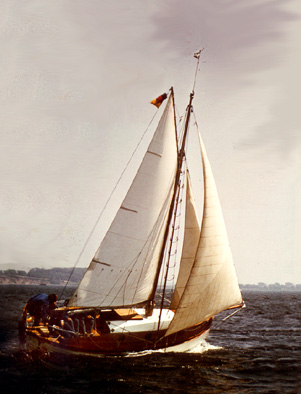
A cutter is a name for various types of watercraft. It can apply to the rig of a sailing vessel, to a governmental enforcement agency vessel, to a type of ship's boat which can be used under sail or oars, or, historically, to a type of fast-sailing vessel introduced in the 18th century, some of which were used as small warships.
Boat racing is a sport in which boats, or other types of watercraft, race on water. Boat racing powered by oars is recorded as having occurred in ancient Egypt, and it is likely that people have engaged in races involving boats and other water-borne craft for as long as such watercraft have existed.

A luzzu is a traditional fishing boat from the Maltese islands. This type of boat developed in the early 20th century, although it is very similar to much older traditional Maltese boats such as the ferilla. They are usually painted in bright colours, while the bow has a pair of eyes.

The kajjik or kajjikk is a traditional fishing boat from Malta. It developed in the 17th century from caïques which were used elsewhere in the Mediterranean. In the past, kajjikki were equipped with sails and oars, but today the fishing boats are powered by inboard motors. Variants of the boat participate in the rowing regattas held twice every year.
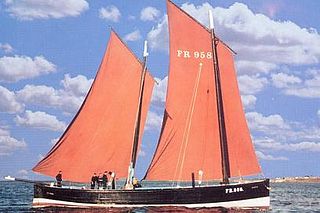
The Fifie is a design of sailing boat developed on the east coast of Scotland. It was a traditional fishing boat used by Scottish fishermen from the 1850s until well into the 20th century. These boats were mainly used to fish for herring using drift nets, and along with other designs of boat were known as herring drifters.
The Scottish east coast fishery has been in existence for more than a thousand years, spanning the Viking Age right up to the present day.

A caïque is a traditional fishing boat usually found among the waters of the Ionian or Aegean Sea, and also a light skiff used on the Bosporus. It is traditionally a small wooden trading vessel, brightly painted and rigged for sail. The caïque is also a typical case of positioning the widest beam far aft, with a long sharp bow.

The vinta is a traditional outrigger boat from the Philippine island of Mindanao. The boats are made by Sama-Bajau, Tausug and Yakan peoples living in the Sulu Archipelago, Zamboanga peninsula, and southern Mindanao. Vinta are characterized by their colorful rectangular lug sails (bukay) and bifurcated prows and sterns, which resemble the gaping mouth of a crocodile. Vinta are used as fishing vessels, cargo ships, and houseboats. Smaller undecorated versions of the vinta used for fishing are known as tondaan.
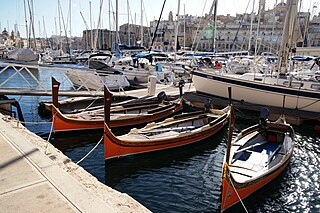
The dgħajsa tal-pass is a traditional water taxi from Malta. It is often simply referred to as the dgħajsa, but this word refers to any type of boat in the Maltese language. The boat developed in the 17th century, and was extensively used to ferry passengers in the Grand Harbour and Marsamxett Harbour between the 18th and 20th centuries. Their use declined in the late 20th century, and today few dgħajjes remain in operation ferrying tourists around the harbours. Variants of the boats are still used extensively in rowing regattas held twice a year.

A fishing vessel is a boat or ship used to catch fish and other valuable nektonic aquatic animals in the sea, lake or river. Humans have used different kinds of surface vessels in commercial, artisanal and recreational fishing.
The yoal, often referred to as the ness yoal, is a clinker-built craft used traditionally in Shetland, Scotland. It is designed primarily for rowing, but also handles well under its traditional square sail when running before the wind or on a broad reach.

Traditionally, many different kinds of boats have been used as fishing boats to catch fish in the sea, or on a lake or river. Even today, many traditional fishing boats are still in use. According to the United Nations Food and Agriculture Organization (FAO), at the end of 2004, the world fishing fleet consisted of about 4 million vessels, of which 2.7 million were undecked (open) boats. While nearly all decked vessels were mechanised, only one-third of the undecked fishing boats were powered, usually with outboard engines. The remaining 1.8 million boats were traditional craft of various types, operated by sail and oars.

A Zeesenboot, in plattdeutsch Zeesboot or Zeeskahn, is a usually 10-metre-long, wide-hulled sailing boat of a type known as a Haffboot. The name is derived from the type of fishing gear used, known as a zeese. The sailing boat is designed for relatively protected, shallow waters. Today zeesenboote are mainly used for leisure sailing.

The Gozo boat was a type of settee-rigged boat originating from Malta. Gozo boats were the main means of transport across the Gozo Channel between Gozo and the main island of Malta from the late 19th to the mid-20th century. The design of the boats developed from the speronara.
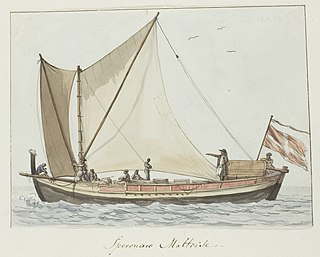
The speronara was a type of small merchant craft originating from Malta which was used in the Mediterranean from the 16th to the early 20th centuries. The vessels usually had no deck and only one mast, often with a lateen or sprit sail. Some larger vessels had a half deck or up to three masts.

A girna is a type of traditional corbelled hut found in rural areas in parts of Malta. They bear similarities with a number of dry stone vernacular building types found in other Mediterranean countries, and they are primarily used for storage or as temporary shelters. It is possible that in the past they were also used for human habitation.
This glossary of nautical terms is an alphabetical listing of terms and expressions connected with ships, shipping, seamanship and navigation on water. Some remain current, while many date from the 17th to 19th centuries. The word nautical derives from the Latin nauticus, from Greek nautikos, from nautēs: "sailor", from naus: "ship".


















